Summary
🇲🇼 We’ve launched our most ambitious program and research yet, delivering funds across an entire district in Malawi, reaching over 185k people and studying the impacts with the largest-ever randomized trial on unconditional cash.
📊 Early data from a sub-district pilot showed sharp reductions in extreme poverty and improved wellbeing with minimal inflation, showing direct cash is a scalable tool to accelerating the end of extreme poverty.
💸 Backed by a $100m anchor commitment from the Canva Foundation, we’ve already begun this unprecedented effort – now we’re scaling up and aiming to build a coalition of funders and innovators to help us realize the vision.
In Malawi, we’re answering a new question: can cash not only transform individual lives but entire communities, accelerating the end of extreme poverty?
The evidence is clear that large, unconditional cash transfers help people escape extreme poverty. Now we’re testing how it works at scale and learning how to make it even more effective along the way.
This is the bold bet, and we’ll need bold partners to help us fund, learn from, and scale what works.
We’re building a coalition to test cash at a transformative scale
Our next step in Malawi is more than just a large study; we’re delivering life-changing support to 185k people currently unable to meet their most basic needs. First and foremost, we send cash because these families deserve the chance to live with dignity today, even as we generate evidence to shape better policy tomorrow.
As much of the world moves up the economic “growth ladder,” 800m people remain stuck below the bottom rung. Cash is one of the most effective and scalable ways to ensure they have the chance to move up.1 And with global aid in retreat, this urgency has only grown.
With a $100m anchor commitment from the Canva Foundation, we’ve secured the funding needed to begin – but not yet complete – this next phase in Malawi.
Today, we’re sharing new results from our sub-district pilot, plus inviting potential funders and partners along for the journey.
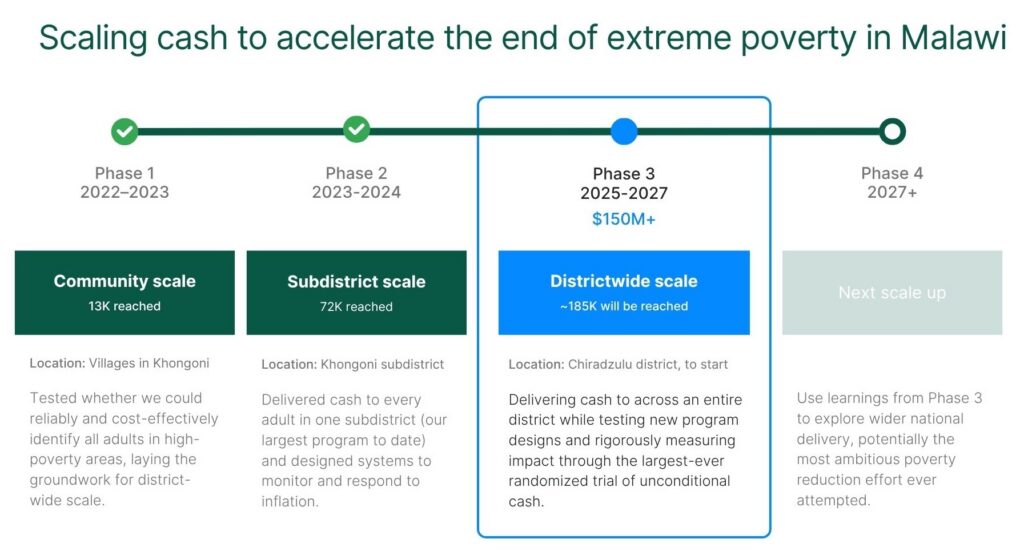
When we paid an entire sub-district, poverty dropped and quality of life improved
Three-quarters of Malawians live on less than $3 a day, making it the poorest peaceful country on earth. That’s why, since 2023, we’ve delivered $52.5m in direct cash to Malawians with support from Canva and other GiveDirectly donors – learning how many people exit extreme poverty, and for how long.
So far, GiveDirectly and Canva have delivered cash equivalent to $550 to every adult in the Khongoni subdistrict of Malawi, reaching over 85k people.
Our last phase tested what happens when large cash transfers are delivered widely, quickly, and without conditions. Here’s what our own surveying found:
Extreme poverty had plummeted 3 months after a one-time payment
The World Bank defines extreme poverty as living on less than $3 per day.2 Before we sent cash, only 18% of adults in Khongoni, Malawi were living above that line. Three months after receiving a one-time $550 transfer, that number jumped to 90%.3
We expect this number may dip over a longer time period, so we’re continuing to measure how persistent these gains are in Khongoni and more rigorously in our next phase to learn more about how far recipients move out of extreme poverty, for how long, and how our programs could better serve those who remain below the line or fall back later on.
📊 Click for the other measures of poverty that improved
While the World Bank sets a numeric poverty line, recipients tell us poverty is more than low consumption. To them, it also meant lacking basic needs, key assets, and dignified work.
When asked what mattered most, people named indicators like safe housing, stable work, and a sense of belonging, many of which had improved 3 months after getting GiveDirectly cash:
💵 A stable income | Result: we found the number of people earning over $1 a day rose by 120%. Business ownership grew 50%. Five months after payments ended, household spending remained ~70% higher than before the cash. Households with savings grew by 153%.
🧺 Enough food to feed their family | Result: people were 200% more likely to eat three or more meals per day. Hunger dropped sharply, including a 77% decrease in people skipping meals so others could eat.
🏠 Adequate and safe housing | Result: Households with iron roofs rose by 92% and with brick walls increased by 35%. Mattress ownership increased by 120%. Solar panel ownership increased 168% and electricity access increased 208%.
📱 Access to tools and transport | Result: Bike and motorbike ownership nearly doubled (93%) and mobile phone ownership more than doubled (107%).
🌾 Land & livestock to earn a better living | Result: On average, $125 of each $550 sent was spent on livestock or agriculture, the biggest transfer spending area. 70% of recipients spent part of their transfer on livestock, increasing large livestock (cow, pig, or goat) ownership by 162%.
📚 Education and health | Result: Students missing school due to cost dropped from 45% to 17%. 84% of recipients experiencing illness or injury sought medical care, significantly higher than the national average of 57%.
🧑🏾🤝🧑🏽 Community belonging | Recipients emphasized the importance of feeling included and able to participate and feel welcomed in their community events. While we didn’t explicitly measure this in the last phase, we’ve updated our surveys to capture it in the next.
Doubling local GDP didn’t drive inflation
Our large scale cash injection was equivalent to doubling the economy in Khongoni. Compared to surrounding areas, inflation in Khongoni rose by about 1% – a statistically detectable but economically negligible effect. After five months, this had fallen to zero.
Markets were able to absorb large-scale transfers without driving significant price inflation. That gives us strong evidence that this model can be scaled responsibly and rapidly without triggering harmful inflation.
This stability was a product of how recipients and markets responded:
- 🗓️ Recipients didn’t spend all at once: Findings showed households did not spend all of the transfer immediately and gradually increased their spending over months.
- 🚲 They also shopped around: Recipients had access to multiple markets, locally and in nearby Lilongwe city, allowing them to choose between sellers if someone didn’t have what they needed or tried to raise prices.
- 🤝 Vendors chose not to raise prices: Traders reported keeping prices steady to maintain trust, saying opportunistic hikes would damage their reputation once the cash was gone.
- 📦 Markets adapted to demand: Many vendors simply ordered more stock and new traders entered markets, both without significantly driving up prices.
📈 Click to see price inflation comparison
Researchers found, “despite the influx of cash, prices remain stable… Overall, we see little difference between the two sets of markets, implying that despite the substantial amount of cash transferred into Khongoni markets, prices remained stable — in other words, Khongoni markets absorbed the additional cash without disrupting price levels.”
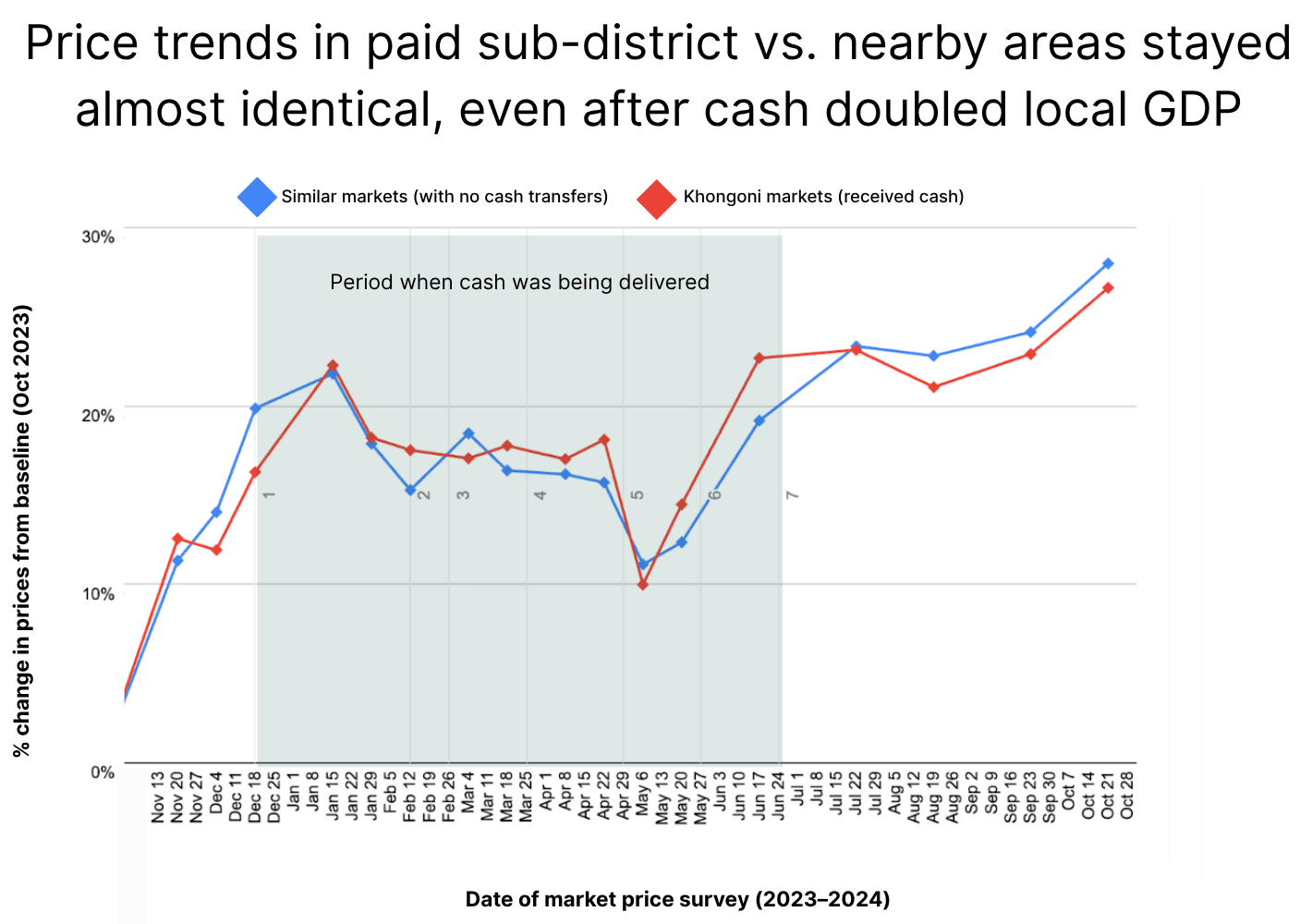
Now we’re scaling up to reach an entire district and learn more
This year, GiveDirectly and Canva launched the next phase of our work in Malawi: delivering $550 at districtwide scale, starting in Chiradzulu and aiming to reach 185k people by early 2027.
We’re asking bigger and better research questions
This next phase is designed based on the results of the last. Run in close coordination with the Malawi government, we’ll deliver the largest unconditional cash program ever implemented in a low-income country. With that scale, we’re asking bigger questions:
- 📈 Can this program drive sustained economic growth and positive spillovers comparable to the 2.5x economic multiplier we saw in Kenya?
- ⏳ How long do recipients’ gains last and how should we measure them?
- ⚖️ Do different program designs (like larger transfers or paired services) yield greater impact?
This means launching the largest-ever randomized controlled trial of unconditional cash in partnership with Oxford University, which will more robustly measure recipients’ exit from poverty among other metrics (see Appendix).
📊 Click to read about our other pilots in this phase
We’ve also launched 10 innovation pilots, testing changes to both scale and design, including:
- 💸 Transfer amounts: what are the impacts of giving $550 vs. $750 vs. $1,000? Are the returns worth giving more?
- 🌱 Complementary services: does giving cash alongside existing education, agriculture, or water interventions have even more impact?
- 📲 AI-powered information access: does pairing cash with smartphones and AI-enabled chatbots giving farming advice have even more impact? (see Appendix)
- 🧱 Community grants: what kind of results does giving village committees $14k to spend on local infrastructure projects yield?
While cash is one of the most cost-effective tools we have, it’s not a ‘silver bullet.’ Transformational change happens when people not only have money in their hands, but also clinics to visit, schools to attend, and roads to travel.
As aid budgets tighten, bold philanthropy can help bridge critical gaps, but strong, functioning government systems and public goods will sustain progress. That’s why understanding how cash complements and strengthens existing infrastructure is essential to truly ending extreme poverty.
This work is only possible thanks to bold philanthropic support
We’re proud to share that this week, the Canva Foundation committed $100m to help launch this scale-up, the largest single gift in our history. Canva’s support will help us reach hundreds of thousands more people, rigorously test new models, and inform aid efforts worldwide.
You can join us for this next phase and beyond
Efforts this ambitious require collective thinking, partnership, and investment. We’re excited to discuss our plans and learn from other philanthropies and institutions interested in building the next stage of this work together.
We’ll keep learning and sharing as we go. And we invite others to join us: to test bold ideas, invest in evidence, and build towards a world where no one lives in deprivation.
We need more donors, big and small, to achieve this next phase and beyond. Give today or email info@givedirectly.org to learn more about our growing coalition.
Together, we can chart a path to ending extreme poverty in our lifetimes.
Appendices
📝 Appendix: Our next surveys will better measure improvements to the ways recipients define poverty
We conducted 45 long form qualitative interviews in Khongoni to learn how our recipients think about and experience poverty. These are the top themes that emerged:
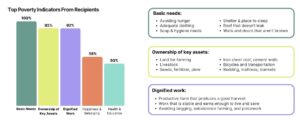
Recipients’ definitions of poverty reveal multiple gaps with the World Bank’s $3/day line:
- Extremely low: measures minimum needed to survive (e.g. minimum calories) but neglects livability
- Only captures consumption not assets: Misses things that a recipient owns, such as a house and education
- Neglects durable investments: Better housing, business or agriculture investments, children’s education are all long-term investments that improve lifetime living standards
- Places no weight on happiness, belonging, or health: Poverty line does not measure spending that improve social bonds and family health
Our new survey questions for Phase 3 will better capture recipients’ definitions of poverty
As we continue measuring how cash reduces poverty, we’re expanding our surveys to better reflect what recipients themselves define as progress. In addition to World Bank consumption measures and our internal program metrics, we’ll be tracking indicators that recipients told us matter most to them.
Here are a few of those priority metrics we’ll monitor regularly:
Basic needs
- 🏠 I have a roof that doesn’t leak
- 🛏️ I have a comfortable place to sleep
- 🧼 I can afford the basic things for my household, such as soap and salt
- 👚 My family and I all have decent clothes
Income & savings
- 💰 I have enough savings/assets to cover my household in case of unexpected difficulties in the future
- 💵 I have a consistent and reliable source of income
Health & nutrition
- 🍽️ I eat two or more meals per day
- 🚰 I have access to clean water from a reliable source
- 🏥 I have access to healthcare services when needed
- 🩺 I have the means to pay for medical expenses when they come up for myself and my family
Community
- 🧺 I have the means to contribute in-kind to community events
- 🚲 It’s easy to travel to a major market from my village
Education
- 🎒 I can afford to send my children to school
- 🏫 There is a school nearby that my children are able to attend
📊 Appendix: Inside the largest randomized controlled trial of unconditional cash to date
To rigorously understand the impact of large-scale cash, GiveDirectly is partnering with researchers from Oxford University, Harvard University, and IDinsight to run the largest-ever randomized controlled trial (RCT) of unconditional cash transfers in a low-income country.
$550 to every eligible adult in Chiradzulu — equivalent to ~125% of annual household income — means injecting the equivalent of 85% of local GDP, offering a unique opportunity to study the macroeconomic impacts of cash at unprecedented scale (~5x larger than comparable trials in Kenya).
The study will also test how markets adjust when local businesses are informed in advance of the cash transfers, allowing them to prepare for rising demand. Researchers will analyze whether this predictability reduces inflation, improves the responsiveness of local supply chains, and increases availability of goods and services for recipients.
The RCT is designed to answer a core set of questions:
- How do large, universal cash transfers affect household well-being, including income, spending, savings, health, and livelihoods?
- What happens to local markets when entire regions receive cash? Do prices spike? Do businesses grow?
- Can the 2.5x economic multiplier observed in Kenya be replicated — or expanded — in this far more ambitious, universal setting?
- Does giving local businesses advance notice of incoming cash transfers enable markets to better prepare for the surge in demand and help boost growth?
GiveWell is also funding part of the data collection effort and reviewing the study’s pre-analysis plan to ensure methodological rigor and transparency. All data and code will be made publicly available, and GiveWell plans to fund an independent replication of the findings upon publication.
How It’s Designed
Cash delivery is randomized at multiple geographic levels — village, group village head (GVH), and traditional authority — to generate natural variation in how cash enters markets. This allows researchers to track differences in market dynamics, supply responses, and household outcomes over time.
Researchers are collecting high-frequency data throughout the study period, including:
- Quarterly household surveys tracking spending, assets, savings, and consumption
- Price tracking for over 100 key products, updated monthly
- Business and trader surveys across both treated and comparison markets
- Market census and infrastructure data to monitor longer-term economic shifts
This mixed-method approach enables researchers to trace out both Engel curves (how spending patterns change with income) and supply curves (how firms respond to shifts in demand) in real time.
💬 Appendix: More on our AI-powered information access pilot
spWe’re piloting a new digital intervention: delivering smartphones equipped with an AI-enabled chatbot that delivers agricultural advice in local languages to test whether access to more advanced tech and targeted information can increase impacts for recipients.
📍 Pilot Design & Rollout
- The pilots launched earlier this year, embedded in our broader district-scale rollout in Chiradzulu.
- Of the 2,800 recipients offered subsidized Itel A18 smartphones, 1,462 had received them by June 2025. These Android devices support WhatsApp and basic mobile internet.
- This is the first time we’re testing smartphone distribution to recipients in Malawi, as our default is to offer feature phones.
💬 The Chatbot: Ulangizi (“Advice”)
- Built and maintained by Opportunity International, Ulangizi (“Advice”) is a WhatsApp-based chatbot that provides interactive agricultural guidance in both Chichewa and English.
- It supports text and voice notes plus image uploads, making it accessible for users with limited literacy or typing ability.
- Recipients can ask questions like “What crops grow well in Chiradzulu?”, and receive responses from an answer bank grounded in national agricultural guidelines.
📝 Evaluation Approach
We’re using a mixed-methods evaluation to assess the pilot’s effectiveness, including:
- Usage tracking (chatbot interactions, internet use)
- Spending behavior (e.g. whether information shifts how recipients use their cash)
- User feedback (on clarity, ease of use, and satisfaction)
- Outcomes related to phone ownership, including theft and resale rates
While the pilot is currently focused on agriculture in rural Malawi, the broader goal is to test scalable digital tools that can layer on top of cash. Future versions could expand into sectors like health or financial literacy, or be adapted for use in new geographies.
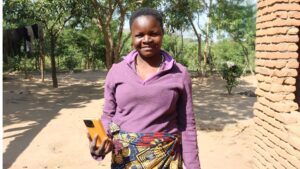
Eliza uses her new smartphone to video call her husband who lives away from the village for work, something she never thought possible. She also gets farming tips through her chatbot on WhatsApp.
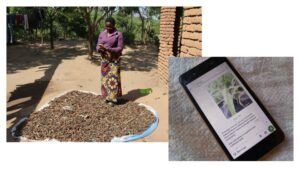
Eliza used her phone to take a picture of her yellowing maize and sent it to the chatbot for advice. She was told her crops needed more nutrients (potassium & nitrogen), and was guided to use the right fertilizer and manure.
- See Brookings Institute on importance of UCTs to end extreme poverty. Furthermore, to achieve Malawi’s own vision of a nation free of extreme poverty, we also need to continue building and strengthening the country’s social protection systems, which amplify the effects of bold philanthropic support. For example: regular government payments to the most vulnerable – like their existing Social Cash Transfer Program – on top of our large lump sum transfers can increase the chance families stay out of extreme poverty for longer, overcoming future shocks and setbacks. ↩︎
- The $3/day line is calculated using Purchasing Power Parity (PPP), a method to adjust for differences in price levels across countries. It ensures that the international poverty line reflects what that amount can actually buy in the world’s poorest economies. The World Bank periodically updates the poverty line using PPP data from the International Comparison Program (ICP); the latest update incorporates 2021 price data to better capture the cost of basic needs like food, clothing, and shelter. ↩︎
- Our consumption surveys of recipients in the Khongoni sub-district found just 18% of adults were living above the World Bank extreme poverty line in the months before our cash transfers. The World Bank’s own surveying found ~15% of the wider Lilongwe Rural district were above the extreme poverty line before our cash was sent. ↩︎